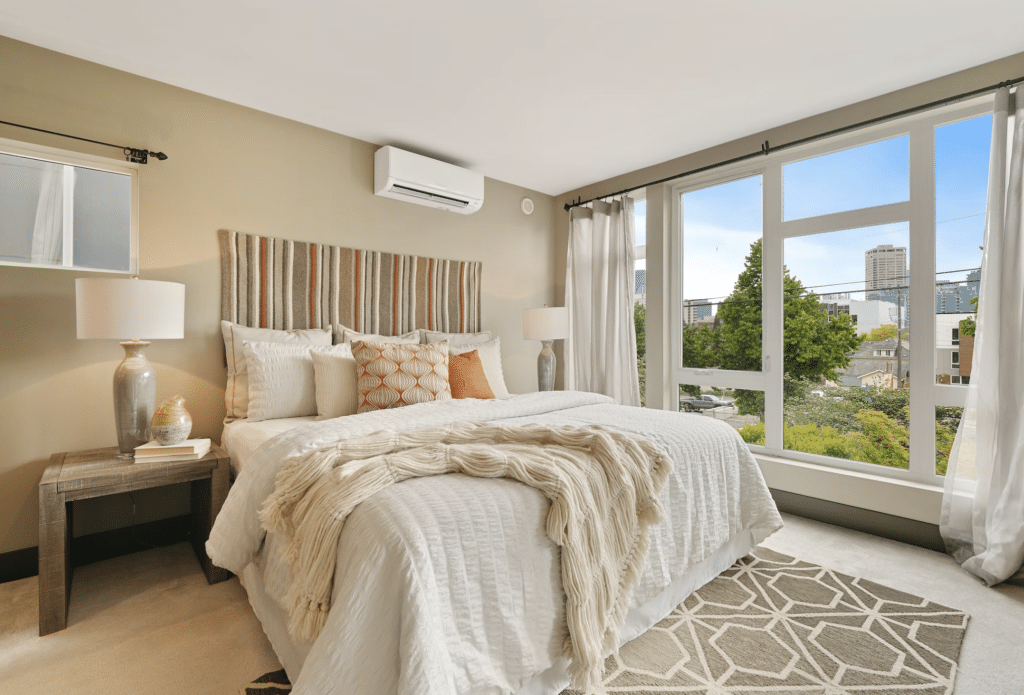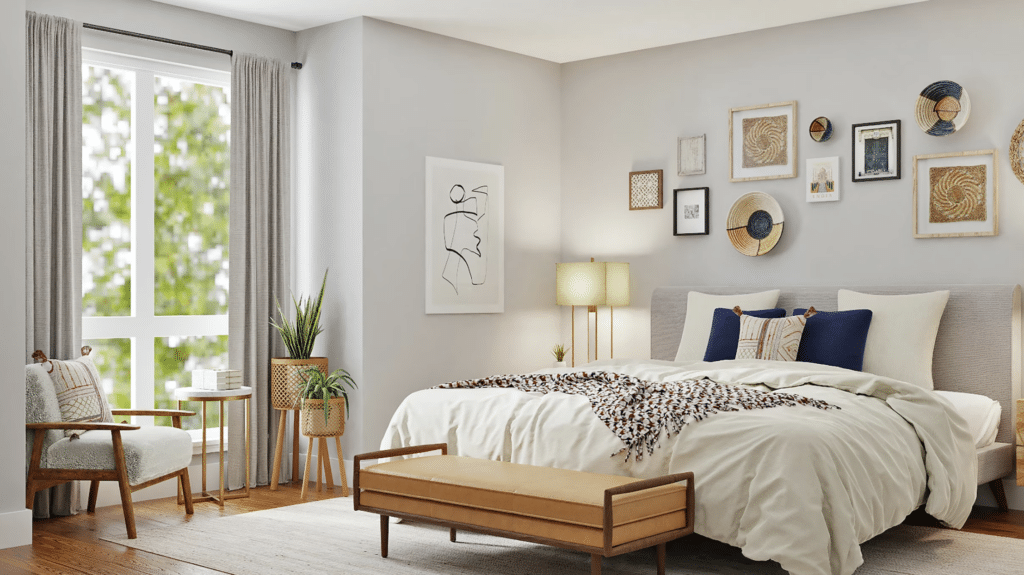Introduction – Eco-Friendly Bedroom
An eco-friendly bedroom is a space that is designed and constructed using environmentally sustainable materials, design, practices, and products. This type of bedroom is beneficial for both the environment and the homeowner, as it reduces energy consumption, waste production, and chemical exposure. Additionally, eco-friendly bedrooms have the potential to save homeowners money in the long run by reducing the cost of energy and water bills.

Examples In Making Eco-Friendly Bedrooms
Natural Materials: Natural materials are the best choice for creating an eco-friendly bedroom. Examples of natural materials include organic cotton, bamboo, and wool. These materials are more energy efficient than synthetic materials and are better for the environment because they are biodegradable. Large items, drawers, shelves, beds should be sourced from eco-friendly vendors. Firms sell eco-friendly bed frames made from materials that is minimally treated and responsibly sourced. Furniture that fit into rooms of other houses follow the same principle – as would a non-toxic sofa in the living room.
Low-VOC Paints: Low-VOC paints are a great choice for creating an eco-friendly bedroom. VOC stands for volatile organic compounds and these paints contain fewer of these compounds, making them less toxic than regular paints. Low-VOC paints are available in a variety of colors and can be used to create a vibrant and colorful bedroom

Sustainable Furniture: Sustainable furniture is another great option for creating an eco-friendly bedroom. This type of furniture is made from sustainable materials such as recycled wood and plastic, and is designed to last for years. Sustainable furniture is also often made with natural materials such as bamboo and cork, which are more environmentally friendly than synthetic materials.
Reduced Energy Consumption: Reducing energy consumption in a bedroom is part of an eco-friendly bedroom because it helps to reduce the amount of energy used, which in turn helps reduce greenhouse gas emissions, air and water pollution, and other environmental impacts associated with energy production and use. Additionally, reducing energy use can save money on energy bills.
Guide To Making An Eco-Friendly Bedroom
Planning: Before building an eco-friendly bedroom, it is important to plan out the design and layout of the room. This includes considering the size of the room, the type of furniture and materials that will be used, and the amount of natural light available. Planning is essential to ensure that the room is both energy efficient and aesthetically pleasing .
Shopping for Materials: Shopping for the right materials is essential for creating an eco-friendly bedroom. It is important to research the materials in order to ensure that they are both eco-friendly and of high quality. This includes researching the sustainability of the materials, such as the energy efficiency of the furniture and the toxicity of the paints.
Installation: Once the materials have been purchased, it is important to install them correctly in order to ensure that the room is as energy efficient as possible. This includes installing insulation, making sure all windows and doors are properly sealed, and ensuring that all furniture pieces are properly secured. It is also important to use eco-friendly installation practices, such as using renewable energy sources for power.
Reduce The Power Consumption Of The Bedroom – 7 Ideas
The main idea here is to reduce energy consumption in the bedroom in every possible way. There will be things that are easily overlooked so we provide a fairly comprehensive guide below. ShrinkThatFootprint has a huge section on energy for our readers.
1. Replace light bulbs with energy-efficient LED bulbs: LED bulbs use up to 85% less energy than traditional incandescent bulbs, and they last up to 25 times longer.
2. Install occupancy sensors: Consider implementing occupancy sensors that not only detect movement but also whether the room is occupied or not. These advanced sensors can be linked to your lighting and HVAC systems to automatically adjust the settings based on the occupancy status, saving energy when the room is vacant.
3. Utilize natural light: Open the curtains and blinds during the day to allow sunlight to naturally light up the room. This will reduce the need for artificial lighting and the associated energy consumption.
4. Invest in energy-efficient appliances: Look for Energy Star-certified appliances, which are designed to use up to 50% less energy than traditional appliances.
5. Install a smart thermostat: Upgrade to a smart thermostat that not only allows programming but can also learn your schedule and preferences over time, making automatic adjustments to optimize energy use. These thermostats can be controlled remotely via a smartphone app, which gives you more control over your energy consumption.
6. Use advanced power strips: Advanced power strips can help manage the power usage of your electronic devices. They can detect when a device is in standby mode and cut power to it, preventing “vampire power” or “phantom load” where devices consume energy even when they are turned off.
7. Use energy-saving curtains: Certain types of curtains are designed to save energy. They can act as insulation to help keep the temperature in the bedroom comfortable while also reducing energy use
Maintaining an Eco-Friendly Bedroom
In order to maintain an eco-friendly bedroom, it is important to keep it clean. This includes regularly vacuuming and dusting, as well as using natural cleaning products that are not toxic. It is also important to use energy efficient cleaning techniques, such as using a vacuum with a HEPA filter or using a damp cloth to dust instead of using a chemical cleaner.
In order to maintain the energy efficiency of an eco-friendly bedroom, it is important to make any necessary repairs. This includes checking the seals around windows and doors, repairing any insulation, and replacing any broken or worn furniture pieces. Making repairs is essential to ensure that the room is as energy efficient as possible.

Conclusion
An eco-friendly bedroom is a great way to reduce energy consumption and waste production, while also saving money in the long run. To create an eco-friendly bedroom, it is important to use natural materials, low-VOC paints, and sustainable furniture. Additionally, it is important to properly plan, shop for materials, and install the room correctly, as well as regularly maintain it
An eco-friendly bedroom has many positive impacts, both for the environment and the homeowner. By reducing energy consumption, waste production, and chemical exposure, an eco-friendly bedroom can help to reduce the overall environmental impact of a household. Additionally, an eco-friendly bedroom can save homeowners money in the long run by reducing energy and water bills.
